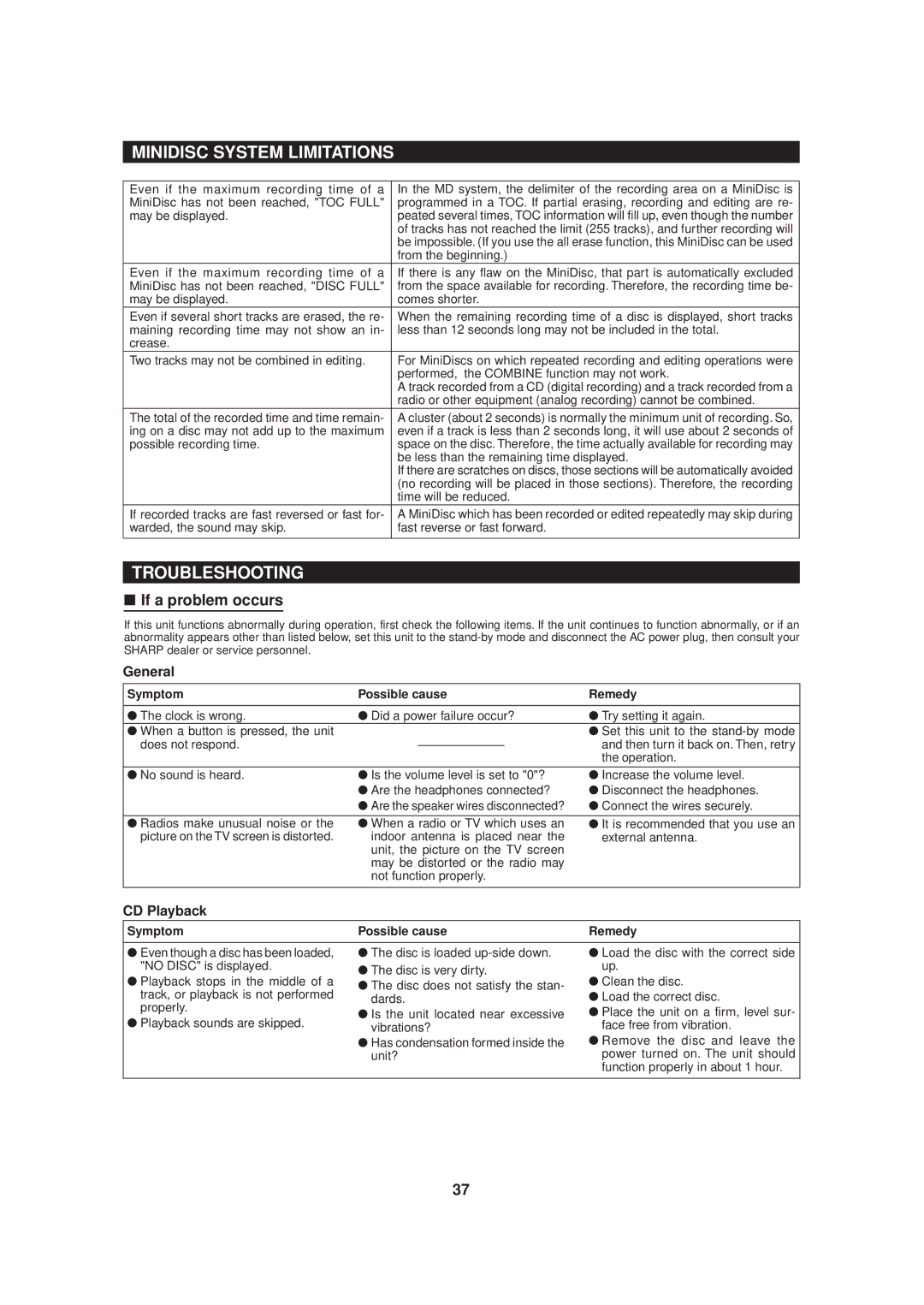
MINIDISC SYSTEM LIMITATIONS
Even if the maximum recording time of a | In the MD system, the delimiter of the recording area on a MiniDisc is |
MiniDisc has not been reached, "TOC FULL" | programmed in a TOC. If partial erasing, recording and editing are re- |
may be displayed. | peated several times, TOC information will fill up, even though the number |
| of tracks has not reached the limit (255 tracks), and further recording will |
| be impossible. (If you use the all erase function, this MiniDisc can be used |
| from the beginning.) |
Even if the maximum recording time of a | If there is any flaw on the MiniDisc, that part is automatically excluded |
MiniDisc has not been reached, "DISC FULL" | from the space available for recording. Therefore, the recording time be- |
may be displayed. | comes shorter. |
Even if several short tracks are erased, the re- | When the remaining recording time of a disc is displayed, short tracks |
maining recording time may not show an in- | less than 12 seconds long may not be included in the total. |
crease. |
|
Two tracks may not be combined in editing. | For MiniDiscs on which repeated recording and editing operations were |
| performed, the COMBINE function may not work. |
| A track recorded from a CD (digital recording) and a track recorded from a |
| radio or other equipment (analog recording) cannot be combined. |
The total of the recorded time and time remain- | A cluster (about 2 seconds) is normally the minimum unit of recording. So, |
ing on a disc may not add up to the maximum | even if a track is less than 2 seconds long, it will use about 2 seconds of |
possible recording time. | space on the disc. Therefore, the time actually available for recording may |
| be less than the remaining time displayed. |
| If there are scratches on discs, those sections will be automatically avoided |
| (no recording will be placed in those sections). Therefore, the recording |
| time will be reduced. |
If recorded tracks are fast reversed or fast for- | A MiniDisc which has been recorded or edited repeatedly may skip during |
warded, the sound may skip. | fast reverse or fast forward. |
|
|
TROUBLESHOOTING
■ If a problem occurs
If this unit functions abnormally during operation, first check the following items. If the unit continues to function abnormally, or if an abnormality appears other than listed below, set this unit to the
General
Symptom | Possible cause | Remedy | ||
|
|
| ||
● The clock is wrong. | ● Did a power failure occur? | ● Try setting it again. | ||
● When a button is pressed, the unit |
|
|
| ● Set this unit to the |
does not respond. |
|
|
| and then turn it back on. Then, retry |
|
|
| ||
|
|
|
| the operation. |
● No sound is heard. | ● Is the volume level is set to "0"? | ● Increase the volume level. | ||
| ● Are the headphones connected? | ● Disconnect the headphones. | ||
| ● Are the speaker wires disconnected? | ● Connect the wires securely. | ||
|
|
| ||
● Radios make unusual noise or the | ● When a radio or TV which uses an | ● It is recommended that you use an | ||
picture on the TV screen is distorted. | indoor antenna is placed near the | external antenna. | ||
| unit, the picture on the TV screen |
| ||
| may be distorted or the radio may |
| ||
| not function properly. |
| ||
|
|
|
|
|
CD Playback
Symptom | Possible cause | Remedy | |
|
|
| |
● Even though a disc has been loaded, | ● The disc is loaded | ● Load the disc with the correct side | |
"NO DISC" is displayed. | ● The disc is very dirty. | up. | |
● Playback stops in the middle of a | ● Clean the disc. | ||
● The disc does not satisfy the stan- | |||
track, or playback is not performed | ● Load the correct disc. | ||
dards. | |||
properly. | ● Is the unit located near excessive | ● Place the unit on a firm, level sur- | |
● Playback sounds are skipped. | |||
vibrations? | face free from vibration. | ||
| ● Has condensation formed inside the | ● Remove the disc and leave the | |
| unit? | power turned on. The unit should | |
|
| function properly in about 1 hour. | |
|
|
|
37
